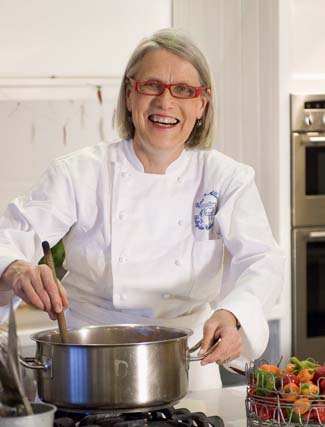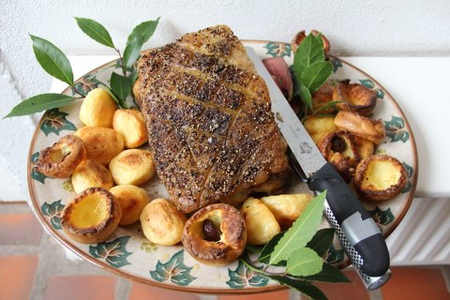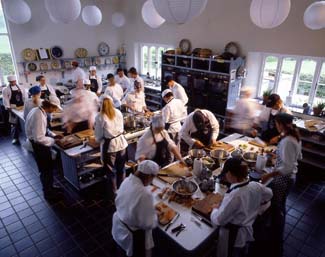The Darina Allen Column - A Real Taste of Irish Produce

It’s not as easy as it sounds to give visitors ‘a real taste of our Irish produce’ - but Darina has the answer to this common problem
I got a wonderful letter beautifully hand-written by a woman who described herself as an octogenarian.
It was a poignant letter and a plea from a woman who wrote in despair about how difficult it now is to source good meat, chicken, pork even beef “Like you, I remember what food used to taste like and nowadays I don’t know where to turn”.
I believe she articulated the challenge that many people face in this era of relentless cost cutting and below cost selling. “Where, oh where can I find nourishing tasty food, I have visitors coming from America and I want to give them a real taste of our Irish produce?”
I totally understand her dilemma and I’m sure many others will also. The kind of produce Helen is looking for is available but rarely through the normal food retail outlets, mostly because the farmers and food producers who still produce food in the traditional, time honoured way must get the full price for their produce – otherwise they simply cannot stay in business.
The reality is that a well reared organic chicken that has been allowed to range freely on grass and grow slowly takes at least 12-13 weeks to reach maturity, over twice the time it takes for a chicken from an intensive Asian production system.
The latter will have antibiotics, hormones, growth promoters, bone strengtheners and probably anti-depressant in every feed. They simply can’t thrive in such intensive conditions otherwise.
Not the sort of bird my correspondent has in mind to remind her guests of almost forgotten flavours from a time when chicken was an occasional treat and the carcass and giblets yielded a fine pot of flavoursome broth.
I sent a list of farmers and food producers that we buy from and including free-range organic poultry producer, Regan Organic Farm, chicken, duck, turkey, pork etc
For pork my first choice was Martin & Noreen Conroy of Woodside Farm, Midleton, Co Cork, phone: 087 2767206.
For beef: go to a local craft butchers with its own abattoir who buys traditional breeds, dry ages and hangs well, for example:
Frank Murphy in Midleton, Co Cork, Phone: 021 4631557
Cliffords Butchers, Castlemartyr, Co Cork, Phone: 021 4667336
Michael McGrath, Butcher in Lismore, Co Waterford, Phone: 058 54350
Dawn Meats, not exactly a small butcher but they have a choice of some excellent well hung meat.
RECIPES:
Traditional Roast Stuffed Organic Chicken with Gravy
Serves 6
A traditional roast stuffed chicken with lots of gravy is a forgotten flavour for many people, partly because unless you have access to a really good bird the smell and flavour will be quite different to one’s childhood memory.
People often feel that making stuffing is too bothersome but if you keep some breadcrumbs in the freezer it can literally be made in minutes. Should I cook the stuffing inside the bird or separately.
The best place for the stuffing is inside the bird where it absorbs lots of delicious juices as it cooks. Do not overfill the bird otherwise the heat may not penetrate fully. This is particularly important if you are using an intensively reared bird which may be infected with salmonella and or campylobacter.
4 1/2 - 5 lbs (1.5 - 2.3kg) free range chicken, preferably organic
Giblet Stock
Giblets (keep the liver for a chicken liver pate), and wish bone
1 thickly sliced carrot
1 thickly sliced onion
1 stick celery, sliced
a few parsley stalks and a sprig of thyme
Stuffing
1 1/2 ozs (45g/1/3 stick) butter
3 ozs (75g) chopped onion
3-3 1/2 ozs (75-95g/1 1/2-1 3/4 cups) soft white breadcrumbs
2 tablespoons (2 American tablespoons + 2 teaspoons) finely chopped fresh herbs eg. parsley, thyme, chives and annual marjoram
salt and freshly ground pepper
a little soft butter
Gravy
1 – 1 1/2 pints (600-900mls/2 1/2 – 3 3/4 cups) of stock from giblets or chicken stock
Garnish
Sprigs of flat parsley
First remove the wish bone from the neck end of the chicken, this is easily done by lifting back the loose neck, skin and cutting around the wish bone with a small knife – tug to remove, this isn't at all essential but it does make carving much easier later on. Tuck the wing tips underneath the chicken to make a neat shape.
Put the wish bone, giblets, carrot, onions, celery and herbs into a saucepan. Cover with cold water, bring to the boil, skin and simmer gently while the chicken is roasting. This is the basis of the gravy.
Next make the stuffing, sweat the onions gently in the butter in a covered saucepan until soft, 10 minutes approx. then stir in the white bread crumbs, the freshly chopped herbs, a little salt and pepper to taste.
Allow it to get quite cold unless you are going to cook the chicken immediately. If necessary wash and dry the cavity of the bird, then season and half fill with stuffing. Season the breast and legs, smear with a little soft butter.
Preheat the oven to 180°C/350°F/regulo4. Weight the chicken and allow about 20 minutes to the lb and 20 minutes over – put on middle shelf in oven. Baste a couple of times during the cooking with the buttery juices. The chicken is done when the juices are running clear.
To test prick the thickest part at the base of the thigh, hold a spoon underneath to collect the liquid, examine the juices - they should be clear.
Remove the chicken to a carving dish, keep it warm and allow to rest while you make the gravy.
To make the gravy, tilt the roasting tin to one corner and spoon off the surplus fat from the juices and return the roasting pan to the stove. De glaze the pan juices with the fat free stock from the giblets and bones (you will need 1-1 1/2 pints depending on the size of the chicken).
Using a whisk, stir and scrape well to dissolve the caramelized meat juices in the roasting pan. Boil it up well, season and thicken with a little roux if you like (the gravy should not be thick). Taste and correct seasoning, serve in a hot gravy boat.
If possible serve the chicken on a nice carving dish surrounded by crispy roast potatoes and some sprigs of flat parsley then arm yourself with a sharp knife and bring it to the table. Carve as best you can and ignore rude remarks if you are still practicing but do try to organise it so that each person gets some brown and some white meat.
Serve with gravy and bread sauce.
Use the cooked carcass for stock.

Serves 8 – 10
1 whole fillet of well hung dried aged beef 2.6kg (6lb) approximately
a few cloves garlic
pork caul fat (if available)
sea salt and freshly cracked pepper
extra virgin olive oil
Béarnaise Sauce (see recipe)
Trim away the chain if it is still attached, use the meat for Beef Stroganoff. Double over the meat at the tapered end and tie the fillet securely with fine butcher’s cotton twine.
Alternatively ask your butcher to do the ‘butchering’ for you.
Rub the fillet all over with a cut clove of garlic, season well with lots of freshly ground pepper and wrap loosely in caul fat if available. Season well with sea salt.
Preheat the oven to 230°C/450°F/Gas Mark 8.
Alternatively, rub the fillet all over with the cut clove of garlic as before, season well on all sides with salt and freshly cracked pepper and drizzle with extra virgin olive oil. Heat a cast iron pan grill to very hot. Sear the beef until nicely browned on all sides. Transfer it to a roasting tin and tuck a couple of sprigs of thyme underneath.
Roast for 25-30 minutes. If you have a meat thermometer, the internal temperature should read 50°C/125°F for rare or 75°C/167°F for well done. Alternatively the meat should feel springy to the touch and the juice should be a pale pink when the meat is pierced with a skewer. Remove from the oven to a carving dish.
Cover and allow to rest for 15-20 minutes by which time the juices will have redistributed themselves and the beef will be uniformly medium rare.
Serve cut in 5mm (1/4 inch) and serve with Béarnaise sauce.
Béarnaise Sauce
The consistency of Béarnaise sauce should be considerably thicker than that of Hollandaise or beurre blanc, both of which ought to be a light coating consistency. If you do not have tarragon vinegar to hand, use a wine vinegar and add some extra chopped fresh French tarragon.
Serves 8–10
4 tablespoons (5 American tablespoons) tarragon vinegar
4 tablespoons (5 American tablespoons) dry white wine
2 teaspoons finely chopped shallots
pinch of freshly ground pepper
2 organic egg yolks
110g (4oz/1 stick) butter
1 tablespoon (1 American tablespoon + 1 teaspoon) freshly chopped French tarragon leaves
Boil the first 4 ingredients together in a low, heavy-bottomed, stainless-steel saucepan until completely reduced and the pan is almost dry but not browned. Add 1 tablespoon (1 American tablespoon + 1 teaspoon) of cold water immediately. Pull the pan off the heat and leave to cool for 1 or 2 minutes.
Using a coil whisk, whisk in the egg yolks and add the butter bit by bit over a very low heat, whisking all the time. As soon as one piece melts, add the next piece; it will gradually thicken. If it shows signs of becoming too thick or slightly scrambling, remove from the heat immediately and add a little cold water. Do not leave the pan or stop whisking until the sauce is made. Finally, add 1 tablespoon (1 American tablespoon + 1 teaspoon) of freshly chopped French tarragon and taste for seasoning.
If the sauce is slow to thicken, it may be because you are excessively cautious and the heat is too low. Increase the heat slightly and continue to whisk until all the butter is added and the sauce is a thick coating consistency. It is important to remember, however, that if you are making Béarnaise sauce in a saucepan directly over the heat, it should be possible to put your hand on the side of the saucepan at any stage. If the saucepan feels too hot for your hand it is also too hot for the sauce!
Another good tip if you are making Béarnaise sauce for the first time is to keep a bowl of cold water close by so that you can plunge the bottom of the saucepan into it if it becomes too hot.
Keep the sauce warm in a Pyrex bowl over hot but not simmering water or in a Thermos flask until you want to serve it.
Pork Belly with Green and Black Olive Tapenade
Inspired by a dish I ate at Amisfield Winery near Queenstown on the South Island of New Zealand.
Serves 6 – 8
1 x 2.2kg (5lb) pork belly with crackling
Rocket leaves
Green and Black Olive Tapenade (see recipe)
flakes of Sea salt
extra virgin olive oil
Score the pork at 5mm (1/4 inch) intervals. Sprinkle both the rind and flesh side with salt and allow to season for 2 – 3 hours. Wash and dry well. Preheat the oven to 180°C/350ºF/Gas Mark 4.
Put the pork, skin side up on a chopping board, season with Maldon sea salt and cracked black pepper. Pour 1cm (1/2 inch) water into a roasting tin and roast the joint on a wire rack in the roasting tin. Allow 25-28 minutes per 450g (1lb). Baste with the rendered pork fat every now and then.
Meanwhile make the Green and Black Tapenade (see recipe).
To Serve
Cut the pork into 5cm (2 inch) squares – allow 3 pieces per person. Drizzle a little chunky tapenade over and around the pork. Sprinkle with some flakes of Sea salt and drizzle with extra virgin olive oil.
Black and Green Olive Tapenade
75g (3ozs) green olives, after stoning
75g (3ozs) black olives, after stoning
2 large cloves garlic, peeled and finely chopped
2 anchovies (Ortiz), mashed
4 tablespoons (5 American tablespoons) extra virgin olive oil
Roughly chop the olives, add the finely chopped garlic, mashed anchovies and extra virgin olive oil. Mix and taste.
---
'30 Years at Ballymaloe' - Bord Gáis Avonmore Cookbook of the Year 2013
Good Food Ireland Cookery School of the Year 2012/2013
***
 Once again, the Ballymaloe Cookery School in East Cork has a great programme of cookery courses for all interests and abilities running throughout 2016. Ranging from a relaxing visit to sit in on an afternoon cookery demonstration to a week long ‘Intensive Introductory Course’.
Once again, the Ballymaloe Cookery School in East Cork has a great programme of cookery courses for all interests and abilities running throughout 2016. Ranging from a relaxing visit to sit in on an afternoon cookery demonstration to a week long ‘Intensive Introductory Course’.
Sitting in the middle of a 100 acre organic farm the Ballymaloe Cookery School provides its students not only with a life skill learnt under the expert tutelage of their very capable teachers but also a place to relax and unwind from the stresses and strains of normal everyday life. The cottage accommodation available onsite for residential courses consists of a collection of delightful converted outbuildings which have been transformed over the years by the Allens, and other accommodation is available locally for the short courses.
www.cookingisfun.ie






There are currently no comments
Leave a comment
Not a member? Register for your free membership now!
Or leave a comment by logging in with: